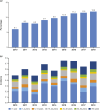Global epidemiology of serogroup Y invasive meningococcal disease: a literature review
- PMID: 39635863
- PMCID: PMC11648504
- DOI: 10.1017/S0950268824001535
Global epidemiology of serogroup Y invasive meningococcal disease: a literature review
Abstract
Serogroup epidemiology of invasive meningococcal disease (IMD) is constantly evolving, varying by time and location. Surveillance reports have indicated a rise in meningococcal serogroup Y (MenY) in some regions in recent years. This systematic literature review explores the evolving epidemiology of MenY IMD globally based on review of recent articles and national surveillance reports published between 1 January 2010 and 25 March 2021. Generally, MenY incidence was low (<0.2/100,000) across all ages in most countries. The reported incidence was more frequent among infants, adolescents, and those aged ≥65 years. More than 10% of all IMD cases were MenY in some locations and time periods. Implementation of vaccination evolved over time as the rise in MenY IMD percentage occurred. Cases decreased in countries with quadrivalent vaccine programs (e.g., United Kingdom, the Netherlands, United States, and Australia), whereas the MenY burden increased and made up a large proportion of cases in areas without vaccine programs. Continuous monitoring of epidemiologic changes of IMD is essential to establish MenY burden and for implementation of prevention strategies.
Keywords: bacteria; clinical manifestiations; infectious disease; meningococcal; serogroups; vaccine.
Conflict of interest statement
M.T.T.H., J.F., and P.B. are employees of Pfizer Inc. and may hold stock or stock options. D.S. is a former employee of Pfizer Inc. and may hold stock or stock options.
Figures




Similar articles
-
Geographical and temporal variations of serogroups and clonal types of Neisseria meningitidis involved in culture-confirmed invasive meningococcal disease in Canada, 2015-2023.J Med Microbiol. 2025 Mar;74(3):001979. doi: 10.1099/jmm.0.001979. J Med Microbiol. 2025. PMID: 40071600 Free PMC article.
-
Epidemiology and economic burden of meningococcal disease in Germany: A systematic review.Vaccine. 2022 Mar 18;40(13):1932-1947. doi: 10.1016/j.vaccine.2022.02.043. Epub 2022 Feb 25. Vaccine. 2022. PMID: 35227520
-
Epidemiological characteristics of invasive meningococcal disease and carriage prevalence of Neisseria meningitidis in the Xinjiang Uygur Autonomous Region, China, 2004-2023: a retrospective study.PeerJ. 2025 Jul 29;13:e19772. doi: 10.7717/peerj.19772. eCollection 2025. PeerJ. 2025. PMID: 40755789 Free PMC article.
-
Safety and immunogenicity of a pentavalent meningococcal conjugate vaccine versus a quadrivalent meningococcal conjugate vaccine in adults in India: an observer-blind, randomised, active-controlled, phase 2/3 study.Lancet Infect Dis. 2025 Apr;25(4):399-410. doi: 10.1016/S1473-3099(24)00576-0. Epub 2024 Nov 6. Lancet Infect Dis. 2025. PMID: 39521012 Clinical Trial.
-
Systematic review of invasive meningococcal disease epidemiology in the Eastern Mediterranean and North Africa region.BMC Infect Dis. 2021 Oct 22;21(1):1088. doi: 10.1186/s12879-021-06781-6. BMC Infect Dis. 2021. PMID: 34686136 Free PMC article.
References
-
- World Health Organization. Meningitis (2023). Available at http://www.who.int/en/news-room/fact-sheets/detail/meningococcal-meningitis (accessed 22 November 2024).
-
- Pelton SI (2016) The global evolution of meningococcal epidemiology following the introduction of meningococcal vaccines. Journal of Adolescent Health 59, S3–S11. - PubMed
Publication types
MeSH terms
Substances
LinkOut - more resources
Full Text Sources
Medical

